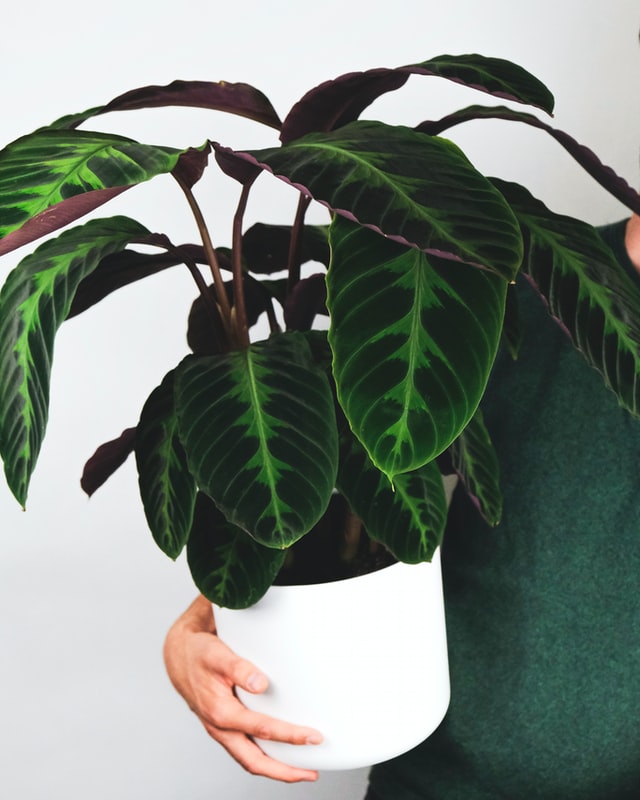
Secrets to Growing Beautiful Calathea No One is Telling You About
Calatheas have a notorious reputation in the houseplant community. They undeniably have some of the most beautiful foliage in the houseplant world. They’re also known for being fussy, crispy, and generally more challenging than they’re worth. If you’ve read all of the Calathea care guides, including my Calathea 101 blog, and you’re still struggling, then you’ve come to the right place. Here are 5 secrets to growing beautiful Calathea that no one is talking about.
1. Start with a healthy plant
This is one secret to growing beautiful calathea that no one is talking about. The best way to grow beautiful calathea is to start off on the right foot. This means that you may need to pass over the offers to “rescue” your friend’s crispy Calathea they are struggling to care for. Instead, choose a full, healthy specimen from a reputable buyer. This can be a local garden centre, plant shop, or online seller who prides themselves in growing and selling healthy plants. Now, by all means, you can follow your heart and get the sad-looking houseplant that speaks to you. Just go into it understanding that it’s much more difficult to revive a sad Calathea than to keep a full, healthy plant healthy. If you want to grow beautiful Calathea, starting with a healthy specimen is the first step.
2. The bigger the better!
With that said, starting with a larger, fuller and well-established Calathea will go a long way. Those tiny, baby Calathea plants are certainly cute and you might be tempted to bring them home! Unfortunately, they are also more delicate and more likely to struggle in less than perfect conditions. And with a higher likelihood of getting crispy leaves, the odd leaf imperfection is much more noticeable in a smaller plant than in a larger, bushy Calathea. A Calathea that’s well established, on the other hand, is a little more resilient, and won’t look completely bare if it drops a leaf or two.

3. Invest in a Humidifier
Calatheas need consistent humidity in order to thrive and maintain their delicate, lush leaves. Unless you live in a humid climate year-round, you will likely need a little bit of help raising and maintaining the high humidity levels needed to keep a Calathea crisp-free in your home. You can measure the humidity in your space by purchasing a hygrometer. There are plenty of hacks to increase humidity in your space, but the most effective “secret” to growing beautiful calathea is with a humidifier nearby. It’s a bit more of a financial investment, but it may save you in the end if you keep tossing your dead Calatheas in the trash. Your other tropical houseplants will also enjoy the humidity and you may even notice some positive effects on yourself as well!
4. Have a pest prevention plan in place
Calathea foliage is soft luscious…and apparently quite delicious to various forms of houseplant pests! Having a pest prevention plan in place will save you a lot of trouble and headaches in the long haul. Nothing can devastate a Calathea faster than a spider mite infestation or thrips. Since their soil is typically kept moist, they also tend to draw in fungus gnats as well. Luckily, gnats aren’t as deadly, but they can be a nuisance. Here are a few Calathea specific pest prevention tips that work well:
- Spray your Calatheas down in the shower at least once a month. They can be sensitive to tap water, yes, but a drink here and there won’t be too harmful unless your water is significantly chemical-laden. Spraying down your Calathea will knock off any pests regularly if they do pop up.
- Use a general pest preventative mixture to spray down your leaves on a regular basis as well. Don’t forget to also clean your leaves regularly to prevent dust from accumulating on your Calathea.
- Maintaining a humid environment will also prevent pests since spider mites in particular love warm, dry environments.
- Keep some yellow sticky tape on hand to combat the fungus gnats.
5. Keep your watering on point
Water is key to keeping a happy and healthy Calathea. If you miss a watering, your Calathea will punish you for it with crispy leaves. Their leaves are thin and tender, so they cannot retain water for long. They need to be watered regularly and don’t enjoy dry soil. They also won’t tolerate living in saturated and wet conditions either. So what can you do? A great tool to determine if your Calathea is ready for water is a moisture meter. Water your Calathea when the moisture meter reads around a 1-2, don’t wait until it has completely dried out. If remembering to water regularly is a struggle for you, but you still want to grow beautiful Calathea, you can look into self-watering pots as well! There are quite a few quality-made self-watering pots that are affordable. Your Calatheas will love them!
*BONUS: Keep Fungicide on Hand
Calatheas are also easily susceptible to fungal issues. Rather than becoming crispy on the tips, fungal issues will emerge in the middle or in sporadic areas, possibly in a circular pattern. Calatheas are easily susceptible to fungus issues particularly because people will often mist them, resulting in water accumulation on their leaves. Keep some fungicide on hand in the event that you notice this happen. It won’t save the affected leaves once the damage has been done, but it will stop the spread and save any new leaves
Now you know the secret to growing beautiful Calathea!
So there you have it! 5 honest secrets to growing beautiful Calatheas that no one is really talking about. If you’d like to continue down the Calathea rabbit hole, take a peek at the additional resources listed below! I know it sounds like a lot of work for just one houseplant, but I know many of you love a good challenge and the foliage is so worth the trouble! Stay curious planty friends! Follow my plant journey on Instagram @plantyquirkyblogger!
Additional Resources:


